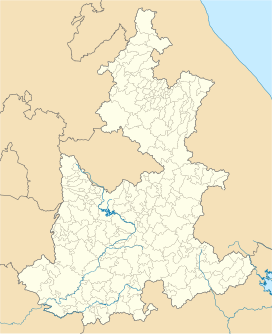Sierra Negra
Appearance
| Sierra Negra | |
|---|---|
 Pico de Orizaba and Sierra Negra viewed from the west, near Ciudad Serdán | |
| Highest point | |
| Elevation | 4,580 m (15,030 ft)[1] |
| Prominence | 540 m (1,770 ft)[2] |
| Coordinates | 18°59′N 97°19′W / 18.983°N 97.317°W |
| Geography | |
| Location | |
| Geology | |
| Mountain type | Stratovolcano |
| Volcanic arc/belt | Trans-Mexican Volcanic Belt |

Sierra Negra (also, and perhaps more properly, Cerro La Negra) is an extinct volcano located in the Mexican state of Puebla, close to the border with Veracruz. At officially 4,580 metres (15,030 ft) above sea level, it is the fifth-highest peak in Mexico. Sierra Negra is overshadowed by nearby Pico de Orizaba (5,610 m/18,406 ft).
Overview
Sierra Negra is located within the
Pico de Orizaba National Park. The mountain is the site for two of the world's premier astronomical instruments, the Large Millimeter Telescope and the High Altitude Water Cherenkov Observatory. Therefore, the access to the mountain is restricted and has to be applied for at least a week in advance.[3]
The service road for this facility is claimed to be the highest road in North America. A part of the telescope facility is visible as a white dot in the first picture below and more clearly in the second picture.
The
INEGI, the official name for the Sierra Negra ("Black Mountains") is Cerro La Negra ("Black Lady Hill"), although the latter is largely unused in common speech. The Nahuatl names Tliltépetl ("Black Mountain") or Atlitzin ("Our Lord (or Lady) of the Waters") are sometimes attached.[3] Speakers of Orizaba Nahuatl
call the mountain Iztactepetl Icni ("Sibling of the White Mountain"; the "White Mountain" being the Pico de Orizaba).
The mountain range to the east of the city of Tehuacán (south of but still in sight of the Pico de Orizaba), with such principal towns as Zoquitlán and Coyomeapan, is also known as the "Sierra Negra", which (unsurprisingly) can cause confusion.
See also
- List of mountain peaks of Mexico
- List of the highest major summits of North America
- Trans-Mexican Volcanic Belt
- National Institute of Astrophysics, Optics and Electronics
- List of national parks of Mexico
References
- INEGI. Retrieved 2016-10-16.
- INEGI. 1985. Retrieved 2016-10-16.
- ^ ISBN 978-607-7607-60-1.
- ISBN 968-58-0590-3.
External links
- "Sierra Negra". SummitPost.org. Retrieved 2016-10-16.
- The Large Millimeter Telescope
- Peakbagger.com: Sierra Negra
- "Pico de Orizaba". Global Volcanism Program. Smithsonian Institution. (includes Sierra Negra)
- Yarza de la Torre, Esperanza (1971). Volcanes de México. Aguilar. p. 237 pp. (in Spanish)


